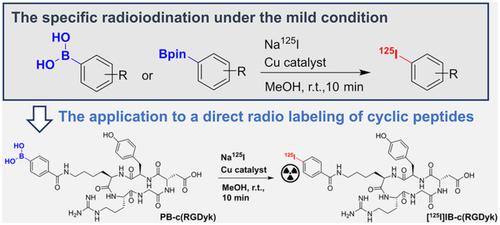当前位置:
X-MOL 学术
›
J. Label. Comp. Radiopharm.
›
论文详情
Our official English website, www.x-mol.net, welcomes your
feedback! (Note: you will need to create a separate account there.)
Copper-mediated radioiodination reaction through aryl boronic acid or ester precursor and its application to direct radiolabeling of a cyclic peptide
Journal of Labelled Compounds and Radiopharmaceuticals ( IF 0.9 ) Pub Date : 2021-05-14 , DOI: 10.1002/jlcr.3925 Yuto Kondo 1 , Hiroyuki Kimura 1 , Chiaki Fukumoto 1 , Yusuke Yagi 1, 2 , Yasunao Hattori 3 , Hidekazu Kawashima 4 , Hiroyuki Yasui 1
Journal of Labelled Compounds and Radiopharmaceuticals ( IF 0.9 ) Pub Date : 2021-05-14 , DOI: 10.1002/jlcr.3925 Yuto Kondo 1 , Hiroyuki Kimura 1 , Chiaki Fukumoto 1 , Yusuke Yagi 1, 2 , Yasunao Hattori 3 , Hidekazu Kawashima 4 , Hiroyuki Yasui 1
Affiliation

|
A copper-mediated radioiodination using aryl boronic precursors is attracting attention as a solution to oxidative iododestannylation and nickel-mediated radioiodination drawbacks. The copper-mediated radiolabeling method allows radioiodination at room temperature with stable aryl boronic precursors without preparing complex starting materials or reagents and can be performed in a reaction vessel exposed to air. This method has good potential in radiochemistry; however, studies on the scope of copper-mediated radioiodination through boronic precursors are insufficient. In particular, few reports have demonstrated the effect of protecting groups on radiolabeling efficiency. Therefore, the effect of the protecting group of aryl boronic acids on the copper-mediated radioiodination was investigated. In addition, this method, which does not require heating, is expected to be useful for direct radiolabeling of peptides. Thus, we attempted direct radioiodination of c(RGDyk) as an example. The resulting radioiodination method was well tolerated in various substrates and was unaffected by the pinacol ester-type protecting group. Also, c(RGDyk) was labeled with 125I via copper-mediated radioiodination using an aryl boronic acid precursor. The reaction time and yield were improved, compared with the indirect method. Furthermore, the large difference in polarity between the boronic acid precursor and the radiolabeled compound facilitated purification.
中文翻译:

通过芳基硼酸或酯前体的铜介导的放射性碘化反应及其在环肽直接放射性标记中的应用
使用芳基硼前体的铜介导的放射性碘化作为氧化碘脱甲烷基化和镍介导的放射性碘化缺点的解决方案引起了人们的关注。铜介导的放射性标记方法允许在室温下用稳定的芳基硼前体进行放射性碘化,而无需制备复杂的起始材料或试剂,并且可以在暴露于空气的反应容器中进行。该方法在放射化学领域具有良好的应用前景;然而,对通过硼前体进行铜介导的放射性碘化的范围的研究还不够。特别是,很少有报告证明保护基团对放射性标记效率的影响。因此,研究了芳基硼酸的保护基对铜介导的放射性碘化的影响。此外,这种不需要加热的方法预计可用于肽的直接放射性标记。因此,我们尝试以 c(RGDyk) 的直接放射性碘标记为例。所得放射性碘标记方法在各种底物中具有良好的耐受性,并且不受频哪醇酯型保护基团的影响。此外,使用芳基硼酸前体,通过铜介导的放射性碘化,用125 I 标记 c(RGDyk)。与间接法相比,反应时间和收率均有所提高。此外,硼酸前体和放射性标记化合物之间极性的巨大差异有利于纯化。
更新日期:2021-06-10
中文翻译:

通过芳基硼酸或酯前体的铜介导的放射性碘化反应及其在环肽直接放射性标记中的应用
使用芳基硼前体的铜介导的放射性碘化作为氧化碘脱甲烷基化和镍介导的放射性碘化缺点的解决方案引起了人们的关注。铜介导的放射性标记方法允许在室温下用稳定的芳基硼前体进行放射性碘化,而无需制备复杂的起始材料或试剂,并且可以在暴露于空气的反应容器中进行。该方法在放射化学领域具有良好的应用前景;然而,对通过硼前体进行铜介导的放射性碘化的范围的研究还不够。特别是,很少有报告证明保护基团对放射性标记效率的影响。因此,研究了芳基硼酸的保护基对铜介导的放射性碘化的影响。此外,这种不需要加热的方法预计可用于肽的直接放射性标记。因此,我们尝试以 c(RGDyk) 的直接放射性碘标记为例。所得放射性碘标记方法在各种底物中具有良好的耐受性,并且不受频哪醇酯型保护基团的影响。此外,使用芳基硼酸前体,通过铜介导的放射性碘化,用125 I 标记 c(RGDyk)。与间接法相比,反应时间和收率均有所提高。此外,硼酸前体和放射性标记化合物之间极性的巨大差异有利于纯化。











































 京公网安备 11010802027423号
京公网安备 11010802027423号